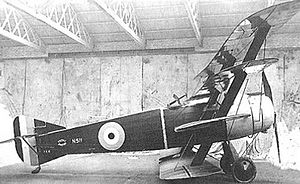
The Sopwith Triplane was a British single seat fighter aircraft designed and manufactured by the Sopwith Aviation Company during the First World War. It has the distinction of being the first military triplane to see operational service.

A triplane is a fixed-wing aircraft equipped with three vertically stacked wing planes. Tailplanes and canard foreplanes are not normally included in this count, although they occasionally are.
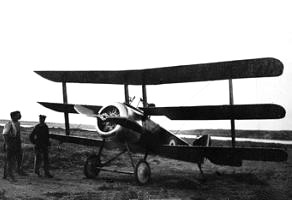
The Alcock Scout, a.k.a. A.1 and Sopwith Mouse, was a curious "one-off" experimental fighter biplane flown briefly during World War I. It was assembled by Flight Lieutenant John Alcock at Moudros, a Royal Naval Air Service base in the Aegean Sea. Alcock took the forward fuselage and lower wings of a Sopwith Triplane, the upper wings of a Sopwith Pup and the tailplane and elevators of a Sopwith Camel, and married them to a rear fuselage and vertical tail surface of original design. It was powered by a 110 hp Clerget 9Z engine, and carried a .303 Vickers machine gun.
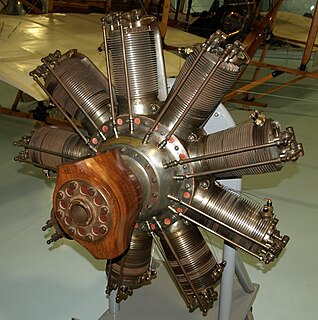
The Clerget 9B was a nine-cylinder rotary aircraft engine of the World War I era designed by Pierre Clerget. Manufactured in both France and Great Britain, it was used on such aircraft as the Sopwith Camel. The Clerget 9Bf was an increased stroke version.
The Armstrong Whitworth Ara was an unsuccessful British single-seat biplane fighter aircraft of the First World War built by Armstrong Whitworth.
The Sopwith Snapper was a prototype British fighter aircraft of the First World War. A single-engined biplane designed by the Sopwith Aviation Company to replace the Sopwith Snipe fighter, it first flew after the end of the war, but did not enter service owing to the failure of its engine, only three aircraft being built.

The Austin A.F.T.3 Osprey was a prototype British fighter triplane of the First World War. Developed by the motor car manufacturer Austin as a replacement to the Sopwith Camel, only one was built, the Sopwith Snipe being preferred.

The BAT F.K.25 Basilisk was a prototype British fighter aircraft of the First World War. A single engined biplane intended to meet a requirement to replace the Sopwith Snipe, the Basilisk was unsuccessful, only three being built.
The Sopwith 2FR.2 Bulldog was a prototype British two-seat fighter of the First World War. A single-engined biplane, the Bulldog was a fighter/reconnaissance aircraft intended to replace the Bristol F.2 Fighter, but was unsuccessful, with no replacement for the Bristol Fighter being purchased.
The Armstrong Whitworth Sissit, also known as the Armstrong Whitworth F.K.1, was a prototype single-engined biplane fighter aircraft of the First World War. The first aircraft designed by Armstrong Whitworth, the Sissit was underpowered and only a single example was built.
The Armstrong Whitworth F.K.5 and F.K.6 were experimental triplanes built as escort fighters by Armstrong Whitworth during the First World War. They carried two gunners in nacelles mounted on the centre wing. One example of each type was built, with no further development or production following.
The Sopwith Long Range Tractor Triplane (L.R.T.Tr) was a prototype British long-range three-seat triplane escort fighter of the First World War. Its unusual layout had a small gunner's nacelle mounted on the upper wing for an all-round field of fire. Only a single example was built, as other, smaller fighters proved more practicable.

The Vickers E.S.1 was an early British Fighter aircraft of the First World War. A single-seat biplane, only three E.S.1s were built, although at least one was used by a home defence squadron of the Royal Flying Corps.
The Sopwith Snark was a British prototype fighter aircraft designed and built towards the end of the First World War to replace the RAF's Sopwith Snipes. A single engined triplane, the Snark did not fly until after the end of the war, only three being built.
The Sopwith 3F.2 Hippo was a prototype British two-seat fighter aircraft of the First World War. It was a single-engined biplane with considerable negative stagger. It was not successful, the Bristol F.2 Fighter being preferred by the Royal Flying Corps.
In aviation, a multiplane is a fixed-wing aircraft-configuration featuring multiple wing planes. The wing planes may be stacked one above another, or one behind another, or both in combination. Types having a small number of planes have specific names and are not usually described as multiplanes:
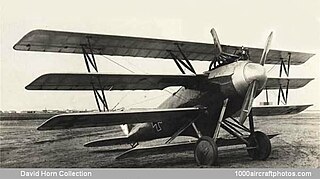
The Naglo D.II was a German single seat quadruplane fighter, flown late in World War I. It took part in one of the fighter competitions but did not reach production.
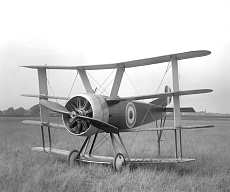
The Wight Quadruplane, also referred to as the Wight Type 4, was a British single seat quadruplane fighter aircraft built by J Samuel White & Company Limited during World War I. Testing revealed design deficiencies and after the only example was involved in a crash, further work on the aircraft was abandoned.

The Naglo D.I was a German single seat quadruplane fighter, flown late in World War I. It took part in one of the fighter competitions but did not reach production.

The Nieuport 17bis C.1 was a World War I French single-seat sesquiplane fighter that was produced under licence in the United Kingdom in small numbers for the Royal Naval Air Service.
